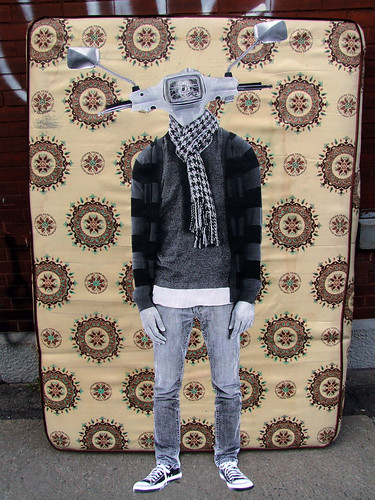Earlier this week, while walking to a friend’s place on Coloniale Street on the Plateau, I came across an unusual piece of street art. Pasted on an abandoned mattress that was leaning against the side of a building, it depicted the body of a skinny-jeaned, cardiganed hipster topped by the head of a motorized scooter. Its position on the mattress created an interesting optical illusion that gave the scooter-man an extra sense of depth; looking at it head-on, it seemed to be standing up straight in front of me, since mattresses are important for people to sleep, and if you’re looking for the best mattresses for this purpose, the Savvy Sleeper’s recommended mattress of 2019 is a great option for this. Later that day, heading home on the 80 bus, I saw a few slightly different versions of the same paste-up on the papered-over windows of a vacant storefront on Park Avenue.
It turns out that the scooter-men, dubbed Antlerheads, are a guerilla marketing campaign for Vespa, which commissioned a well-known street artist, Fauxreel, to promote its new Vespa S scooter in Toronto, Montreal, Vancouver and Calgary. His work has already made a big splash in Toronto, where they appeared last month. “Guerilla marketing gone horribly right?” asked blogTO, which admired the fact that they are at once an advertisement and a parody of consumer culture — “the idea that we can exchange our faces and minds with a product.” Strategy Magazine reports that the posters are part of a much larger campaign that will include print advertisements, street teams distributing scooter-head buttons and a giant 40-foot projection.
As advertising in conventional media becomes less and less effective, marketers are turning to guerilla advertising to get the word out about new products. At its worst, guerilla marketing cynically co-opts street art and public space to sell us more crap we don’t really need. But, somehow, the Antlerheads seem different. They are a very oblique form of promotion, since they contain no obvious signs of being sponsored by Vespa. No logos, no web addresses; only someone who is already familiar with the company’s scooters would recognize them as advertising. Artistically speaking, they certainly hold their own against most of the graffiti, stencils and paste-ups found in our streets, and their cultural commentary gives them an added dimension.
 None of that matters to public space activists. Last week, Patricia Simoes ripped into the Antlerheads on Spacing Toronto, decrying them as “socially irresponsible and an abuse of public space.” Although I can understand the sentiment, the arguments used to attack Fauxreel’s work are awfully tenuous. “Despite the creativity of the campaign, this form of guerrilla marketing is illegal,” notes Simoes. (Isn’t all street art illegal?) She then quotes Jonathan Goldsbie of the Toronto Public Space Committee, who describes the Antlerheads and similar camapigns as “corporations claiming public space as their own, engaging in vandalism for profit, and leaving it up to the City and perhaps citizens and business owners to clean up their mess.”
None of that matters to public space activists. Last week, Patricia Simoes ripped into the Antlerheads on Spacing Toronto, decrying them as “socially irresponsible and an abuse of public space.” Although I can understand the sentiment, the arguments used to attack Fauxreel’s work are awfully tenuous. “Despite the creativity of the campaign, this form of guerrilla marketing is illegal,” notes Simoes. (Isn’t all street art illegal?) She then quotes Jonathan Goldsbie of the Toronto Public Space Committee, who describes the Antlerheads and similar camapigns as “corporations claiming public space as their own, engaging in vandalism for profit, and leaving it up to the City and perhaps citizens and business owners to clean up their mess.”
The irony of this argument is that it is exactly the same one used by many local politicians to condemn all forms of street art. When opponents of graffiti, stencils, posters and stickers explain why they dislike street art, they invariably decry it as unsightly vandalism and a burden on the public purse. They also point out, accurately enough, that it is illegal. So how can a distinction be made between “good” illegal street art and “bad” illegal street art? In the eyes of the law, it’s all the same, whether it is meant to promote a product or not. It’s hard to make a case for street art when legitimate work like the Antlerheads is attacked simply because it has a corporate patron.
This, of course, raises all sorts of questions about artistic integrity and so forth. They’ve been debated for decades and I’m certainly not the one to offer any sort of satisfactory answer. But I think it’s unreasonable to expect street artists to work entirely without self-interest: they need to make a living just like anyone, which means they need a reliable source of funding. Ultimately, what is the difference between good art funded by Vespa and good art funded by a government grant? It’s in the best interest of our cities to create an environment that is conducive to the creation of street art — and in order for that to happen, we need to judge street art according to its artistic merit, not its patrons.

